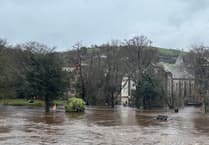A RARE fossil which experts believe may be 375 million years old, has been unearthed in a Totnes garden.
The 8cm long fossil was found by observant Totnes Museum archivist Sue King in a garden below the medieval walls of Totnes Guildhall.
Sue sent a photo of her find to Geologist Dr Kevin Page, a senior researcher at Exeter University, who identified it as a rare record of plant life dating from the Devonian Period.
From the photo, Dr Page assessed the fossil to be part of one of the earliest trees on earth - a primitive lycopsid which is related to the modern diminutive club mosses.
Friend and local geologist James Bellchambers hailed Sue’s find “unique.”
“At first it may look like a piece of shark skin, but it is much more important and is causing a quiet stir in academic circles,” he said.
“Even the great Victorian fossil hunters may never have seen one.”
James said the South Hams was very different during the Devonian Period when the fossil was formed as much of what is now South Devon lay to the south of the equator.
He explained: “There were warm shallow seas with areas of coral-rich reefs which, over time, formed hard, fossil-rich limestones as at Berry Head or Shinners Bridge at Dartington.
“The muddy sea floors became compacted to form what in Devon is often called ‘shillet’. Some turned into the familiar roofing slates which hang on the fronts of many Totnes houses.”
Sue’s tree fossil orginally came from the rocks of Totnes Down Hill – south of the town – which are largely formed of layers of volcanic ash known as the Ashprington Volcanic Formation, said James.
“A landmass, or islands, must have stood above the shallow seas. Between the volcanic eruptions, the flanks of the volcano and the land that rose above the shallow seas would have been colonised by the pioneer green plants.
“The broken volcanic stone from Totnes Down Hill makes a good random-rubble building material and was used for the construction of the old town walls and of the castle.
“At Dorsely, on the Avonwick road, there is a quarry in the very hard dolerite rock which may have been formed in the vent of one of the volcanos. That rock made a very durable gravel for road making.
“The only other yet identified site which may have yielded similar fossils is also within the same volcanic formation of South Devon. It was discovered in 2019 but is currently being kept secret whilst scientific studies continue.”
James continued: “People will be familiar with pictures of the forests that formed the coal fields of South Wales from some 320 million years ago during the Carboniferous times. The Devonian forests were similar but a lot earlier.
“There were no reptiles or amphibians, but from a famous site in Scotland we know that there would have been mites and early hexapods such as ‘springtails’
“Traces of forests with ‘trees’ similar to Sue’s lycopod are known from elsewhere in the world, for instance in Spitzbergen off Northern Norway and in New York state, but this is the first time that they may have been recognised in England.
“The Totnes Down Hill quarries are now lost in vegetation and inaccessible, but it may still be possible to find such fossil specimens in the medieval town walls and gardens .
“Readers, please keep your eyes open and let Totnes Museum know if you find anything, as you will be really helping to push back the frontiers of science and our understanding of an ancient world very different to our own.”





Comments
This article has no comments yet. Be the first to leave a comment.